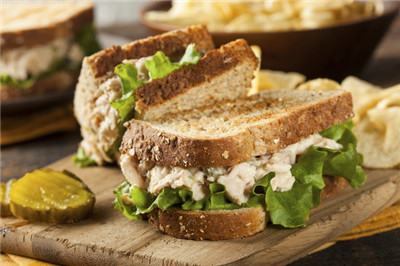(单词翻译:单击)
For years pregnant women have been warned about eating tuna because of concerns about mercury exposure. But a federal panel has reignited the debate about the benefits and risks of eating tuna and other seafood during pregnancy.
多年来,因为汞污染问题,孕妇一直被警告不宜食用金枪鱼。然而,联邦政府的一个顾问小组最近却就妊娠期食用金枪鱼等海产品的风险和收益,重新挑起了争论。
Experts agree that seafood is a rich source of important nutrients, and that most of us don’t eat enough of it. Fish is rich in omega-3 fatty acids, B vitamins, iodine, selenium and vitamin D. And numerous studies show that the nutrients in fish are particularly important for brain development in fetuses and nursing infants.
专家们一致认为海产品是重要营养物质的丰富来源,且我们大多数人的海产品摄入量都不足。鱼肉中富含ω-3脂肪酸、B族维生素、碘、硒和维生素D。众多研究表明,鱼肉中的营养物质对于胎儿和哺乳期婴儿的大脑发育尤为重要。

As part of a sweeping review of nutrition recommendations, the Dietary Guidelines Advisory Committee recently reiterated the current seafood guidelines: Americans should eat a wide variety of seafood. The report also acknowledges the risk of mercury exposure from certain kinds of seafoods, and notes that women who are pregnant, nursing or may become pregnant should avoid certain kinds — tilefish, shark, swordfish and king mackerel — because of their high mercury content.
此次对营养建议的全面复审由美国膳食指南咨询委员会(Dietary Guidelines Advisory Committee)负责。作为这项工作的一部分,该小组最近重申了当前的指南:美国人应食用多种多样的海产品。其报告承认某些种类的海产品存在汞暴露风险,并指出孕妇、哺乳期或备孕女性应避免食用某些汞含量偏高的鱼类:方头鱼、鲨鱼、箭鱼和王鲭。
The panel withheld a recommendation about tuna, second only to shrimp in popularity in the United States. Current guidelines from the Food and Drug Administration and the Environmental Protection Agency warn pregnant and nursing women to limit tuna consumption to six ounces per week.
但是,该小组并不赞同关于金枪鱼,也就是美国仅次于虾的第二受欢迎的海产品的建议。美国食品和药品监督管理局(Food and Drug Administration)和美国国家环境保护局(Environmental Protection Agency)的现行指南警告:孕妇和哺乳期妇女应将金枪鱼的摄入量限制在每周6盎司(约合170克)。
The advisory committee has recommended that these agencies “re-evaluate” their stance on tuna for pregnant women. In the report, the panel argues that albacore tuna is a “special case.” They noted that even when women ate double the recommended weekly amount of tuna, the benefits far outweighed the risks. “All evidence was in favor of net benefits for infant development and (cardiovascular disease) risk reduction,” the panel wrote.
咨询委员会建议上述机构“重新评估”他们在孕妇食用金枪鱼问题上的立场,并在报告中指出:长鳍金枪鱼应作为一个“特例”。即使妇女食用每周建议量两倍的金枪鱼,其净收益也远远大于风险。“所有的证据都支持它有益于婴儿发育,并可降低(心血管疾病)的风险。”
The suggestion that pregnant women can eat more white albacore tuna — the type of tuna typically used in canned tuna — has upset advocacy groups that have called for increased warnings about mercury on tuna packaging.
顾问小组表示孕妇适当多吃些白长鳍金枪鱼(常用于制作金枪鱼罐头)也无妨,这令大声疾呼应对包装金枪鱼食品的汞污染提高警惕的宣传组织十分不满。
“Tuna is responsible for nearly seven times more mercury exposure than the four high-mercury fish that the Federal Food and Drug Administration advises pregnant women not to eat,” said Michael Bender, director of the mercury policy project, in a statement. “So why would the proposed 2015 dietary guidelines recommend that pregnant women eat more of it?”
“金枪鱼中的汞污染是美国食品和药品监督管理局建议孕妇不要食用的四种高汞鱼类的近七倍,”汞政策项目”(mercury policy project)的负责人迈克尔·本德尔(Michael Bender)在一份声明中称。“那么,又为何提出在2015年的膳食指南中建议孕妇多吃金枪鱼?”
But Dr. Steve Abrams, a panel member involved in the seafood recommendations and medical director of the Neonatal Nutrition Program at Baylor College of Medicine, said that while women need to be aware of the types of fish they are eating, the evidence is strong that fish consumption by mothers is good for the brains of their babies.
但是,参与制定海产品膳食建议的顾问小组成员、美国贝勒医学院(Baylor College of Medicine)新生儿营养项目(Neonatal Nutrition Program)主任史蒂夫·艾布拉姆斯(Steve Abrams)博士表示,虽然妇女需要对自己食用的几种鱼类多加注意,但强有力的证据显示母亲食用鱼肉对婴儿的大脑有好处。
“The goal of the dietary guidelines is to give people a healthy way to eat and not to include or exclude certain foods,” said Dr. Abrams. “The benefit of having (omega-3 fatty acids) in your diet really exceeds the likely risk of contamination. The point is that you should have a variety of types of seafood and not limit yourself to one type, and variety includes canned tuna.”
“膳食指南的目的在于指导人们以健康的方式饮食,而不是将某些食物纳入或排除出食谱,”艾布拉姆斯博士说。“膳食中加入含(ω-3脂肪酸)的食物带来的收益大大超过了可能的污染风险。问题的关键是,你应该食用包括金枪鱼罐头在内的多种的海产品,而不是局限于某一特定种类。”
Alice Lichtenstein, senior scientist and director of the Cardiovascular Nutrition Laboratory at Tufts University said the panel hasn’t suggested that pregnant women eat more tuna. “The issue of fish contamination is a moving target and you need very current data,” said Dr. Lichtenstein. “It may be that the issue is re-evaluated and there is no change.”
塔夫茨大学(Tufts University)心血管营养实验室(Cardiovascular Nutrition Laboratory)主任、资深科学家艾丽斯·利希滕斯坦(Alice Lichtenstein)表示,该小组并未建议孕妇多吃金枪鱼。“鱼肉污染的情况无时无刻不在发生变化,需要研究即时的数据,”利希滕斯坦博士说。“很可能,在重新评估过该问题后,发现无需做出改变。”
Mercury levels in our oceans are on the rise due to an increase in industrial mercury emissions. Plants, plankton and tiny fish that have absorbed small amounts of mercury are eaten by larger fish. Over time, large fish sharks and swordfish accumulate high levels of mercury. As a result, health officials recommend fish like sardines, salmon, tilapia and trout that are lower on the food chain and have accumulated less mercury in their tissue.
工业汞排放的增加造成海洋中的汞含量持续上升。植物、浮游生物和小鱼体内都吸收了少量的汞,而它们又是大鱼的口中餐。随着时间的推移,鲨鱼和箭鱼等大型鱼类体内就积累了高浓度的汞。因此,卫生官员建议人们食用位于食物链较低位置,组织中积累汞含量较少的鱼类,如沙丁鱼、鲑鱼、罗非鱼和鳟鱼等。
The benefits of fish consumption on a developing fetus are clear. In a Harvard study of 135 mothers and infants, researchers tracked fish consumption during pregnancy and tested the mother’s hair to measure her mercury exposure. They found that for each weekly serving of fish the mother ate while pregnant, her baby’s score on visual recognition memory tests increased an average of four points. At the same time, a baby’s score dropped by 7.5 points for every one part per million increase in mercury found in the mother’s hair sample. The babies who scored highest on the memory tests were those whose mothers had consumed two or more servings of fish each week during their pregnancy, but were tested to have very low mercury levels.
食用鱼肉对发育中的胎儿的益处显而易见。在哈佛大学(Harvard)的一项研究中,科学家们以135对母婴为研究对象,跟踪了母亲在妊娠期食用鱼肉的情况,并检测了母亲的头发以测定其汞暴露程度。他们发现,孕妇每食用一周份的鱼肉,日后其孩子在视觉识别记忆测试中的得分平均将增加四分。同时,母亲头发样本中的汞含量每增加一百万分之一(p.p.m.),她孩子的上述得分就会降低7.5分。当母亲在妊娠期间每周至少食用两份鱼肉,头发检测出的汞浓度又非常低时,孩子在记忆测试中得分最高。
Health officials have long worried about balancing warnings about mercury against the obvious benefits of consuming more fish. Currently fewer than one in five Americans eats the recommended two servings a week of fish. About one-third eat one serving of seafood weekly and nearly half of us eats very little seafood or none at all.
长久以来,卫生官员在究竟是强调多吃鱼好处多多还是警惕汞摄入量之间,举棋不定。目前,只有不到五分之一的美国人遵照建议每周食用两份鱼肉。约三分之一的人每周食用一份海产品,近一半人仅食用很少或根本不食用海产品。
This fall Consumer Reports issued a lengthy paper on fish and mercury exposure, noting the special concerns about canned tuna due to its popularity. Six ounces of canned tuna contains 60 micrograms of mercury compared to just 4 micrograms of mercury in a six-ounce serving of salmon, according to Consumer Reports. (A six-ounce serving of swordfish contains 170 micrograms, the magazine said. )
去年秋天的时候,《消费者报告》(Consumer Reports)发表了关于鱼类和汞暴露的长篇文章,并对广受欢迎的金枪鱼罐头表示了特别关注。《消费者报告》称,6盎司金枪鱼罐头中含有60微克的汞,相比之下,一份6盎司的鲑鱼中汞含量只有4微克。(该杂志还称,一份6盎司的箭鱼中含有170微克的汞。)
For people who want to safely eat more seafood, the magazine recommended shrimp, scallops, sardines, salmon, oysters, squid and tilapia as the lowest-mercury seafood. Also low are haddock, pollock, flounder and sole, Atlantic croaker, crawfish, catfish, trout, Atlantic mackerel, crab and mullet. In addition to the usual warnings about high mercury fish, Consumer Reports added marlin and orange roughy to the list. They suggested limiting consumption of grouper, Chilean sea bass, bluefish, halibut, black cod, Spanish mackerel and fresh tuna.
杂志建议,如果想要放心地食用较大量的海产品,可选择虾、扇贝、沙丁鱼、鲑鱼、牡蛎、鱿鱼和罗非鱼等汞含量最低的海产品。其他汞含量较低的品种有:黑线鳕、青鳕、比目鱼和鳎、细须石首鱼、小龙虾、鲶鱼、鳟鱼、大西洋鲭鱼、蟹和鲻鱼。高汞鱼类的警告列表中,除了常见的那几种之外,《消费者报告》又补充了马林鱼和大西洋胸棘鲷。建议有限制地食用的鱼类有:石斑鱼、智利海鲈鱼、扁鲹、星鲽、银鳕、马鲛鱼和新鲜金枪鱼。


